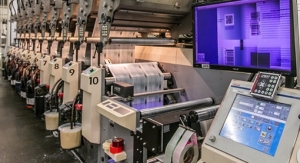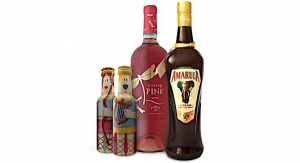10.12.18
The challenges of efficient production are not exclusive to flexo presses. Digital presses can offer challenges based on a number of factors, including the variety of ink sets, substrates and the presses themselves. Eliminating color-based click charges, reducing the cycles—and thus, time on a press—and correctly estimating jobs can all contribute to speed-to-market and customer satisfaction.
Fortis Solutions Group (Fortis) found that Esko Color Preflight helped accomplish each of these objectives. Based in Virginia Beach, Fortis, a L&NW Company To Watch in 2015, is the combination of multiple companies with rich histories. Founded in 1979 as Labels Unlimited, the company grew quickly, primarily serving the food and beverage industries with distribution capabilities across the US, Canada and the Caribbean. Under new ownership in 2010, they continued their growth trajectory through organic growth and acquisitions, leading to the formation of Fortis Solutions Group in 2015. In July, Fortis announced its sixth acquisition, the acquisition of Lewis Label Products Corporation, a custom manufacturer of pressure sensitive labels, shrink sleeves and flexible packaging products.
“We are customer driven and focused on quality and brand color accuracy,’” says Marybeth Foss, director of prepress at Fortis. With the launch of its “One Fortis” initiative, Fortis Solutions Group operates effectively as one company with many local facilities. Using Color Preflight, it produces consistent color regardless of the press or production facility. The company has multiple HP Indigo 6800 presses to complement its numerous flexo presses at its facilities. It was a major challenge to determine which press should produce a certain job, and which ink set should be used.
“We were using a makeshift manual method, collecting data and creating rough profile averages to predict color strategies. Operators would decide on their own best color strategy. Some preferred to use the HP Indigo Enhanced Productivity Mode (EPM) that, even without black ink, could pretty much produce the entire top half of the Pantone book. It’s popular among customers whose labels include photos,” comments Foss. “However, others decided to print with orange and violet for a wider gamut.”
Every time the same job came up, a different strategy could be selected, leading to production inconsistencies. By achieving more accuracy, speed, repeatability and ink use for new presses and substrates, Fortis could improve efficiencies and, ultimately, increase production flexibility.
“We were manually entering data when we added a press, new colors or substrates. We’re a growing company. It was hard to scale up. We needed a simple, easy process to determine color strategies,” notes Foss. “So, we decided to collaborate in the development of Esko Color Preflight, a module within Esko Automation Engine.”
Color preflight finds the fastest and most cost-effective way to print jobs on any press, while meeting demanding brand color expectations. It allows operators to select the most efficient ink set, eliminate unnecessary print time, and make use of EPM (or other print modes) with confidence.
“Knowing that we can accurately print with three colors rather than CMYK provides big time savings,” notes Foss. “More and more jobs are running with EPM and clients are happy with the color results.”
Fortis also uses color preflight to determine what is most consistent for production, eliminating the human variable. The challenge with digital is to know whether spot colors can be matched to customers’ expectations before deciding to print on a digital press.
The same process can be applied to traditional presses. By pulling raw data from Esko Color Engine, Fortis can also test against different flexo strategies, determining the ∆E using process inks on a flexo press. Color preflight also allows estimators to make the most competitive decision for a job, up-front. Once the best solution is determined, the system will always make the same choice for reprints, so there is no variation.
With a color preflight system, Fortis ensures a consistent product while saving time and maintaining quality. “This assures reliability and predictability,” says Foss.
Color preflight helps eliminate rejections and quality concerns from variable, inconsistent color strategies for reprints. Fortis’ press operators are not tweaking colors, which can tie up time and materials. Fortis estimates costs more accurately, and they can make more informed production decisions about EPM or, perhaps, expanded gamut. Using an HP Indigo 6800 with inline spectrophotometry, Fortis has accurate Pantone color matching. Both Esko Color Preflight and the HP DFE share a direct, real-time connection to the Esko Color Engine database. This ensures estimating and production are guaranteed identical results. They are not using as many special designer inks as before because they have been able to target to the Pantone digital library. Fortis can print with a wider color gamut so more Pantone colors are matched.
“As we add equipment or substrates, Color Preflight helps our scalability. The number of inks required and ∆E data is important to all print methods. Any strategy that is created and stored in Color Engine software can be used to evaluate ∆E and ink data,” explains Foss. “Color Preflight allows us to do all this in real-time. As soon as a designer ink is built into the system, we can predict it. The database updates instantly with the additions of designer inks or tweaks to dial in or add Pantone colors to the strategy.”
Because Fortis can target each press specifically, they can schedule jobs on each press and gang jobs more easily, which helps improve efficiency. “We also like the ease of use,” adds Foss. “Color Preflight works by itself, or we can be creative and build workflows with the help of Esko Automation Engine. The process is basically plug and play. “If you have a digital press with an inline spectrophotometer and you are conducting media fingerprints, Color Preflight could be a good investment,” concludes Foss. “It’s very easy to use and provides consistent and reliable results every time, referencing to the most recent data available in your color database. Color preflight is scalable, reliable, and consistent.”
Fortis Solutions Group (Fortis) found that Esko Color Preflight helped accomplish each of these objectives. Based in Virginia Beach, Fortis, a L&NW Company To Watch in 2015, is the combination of multiple companies with rich histories. Founded in 1979 as Labels Unlimited, the company grew quickly, primarily serving the food and beverage industries with distribution capabilities across the US, Canada and the Caribbean. Under new ownership in 2010, they continued their growth trajectory through organic growth and acquisitions, leading to the formation of Fortis Solutions Group in 2015. In July, Fortis announced its sixth acquisition, the acquisition of Lewis Label Products Corporation, a custom manufacturer of pressure sensitive labels, shrink sleeves and flexible packaging products.
“We are customer driven and focused on quality and brand color accuracy,’” says Marybeth Foss, director of prepress at Fortis. With the launch of its “One Fortis” initiative, Fortis Solutions Group operates effectively as one company with many local facilities. Using Color Preflight, it produces consistent color regardless of the press or production facility. The company has multiple HP Indigo 6800 presses to complement its numerous flexo presses at its facilities. It was a major challenge to determine which press should produce a certain job, and which ink set should be used.
“We were using a makeshift manual method, collecting data and creating rough profile averages to predict color strategies. Operators would decide on their own best color strategy. Some preferred to use the HP Indigo Enhanced Productivity Mode (EPM) that, even without black ink, could pretty much produce the entire top half of the Pantone book. It’s popular among customers whose labels include photos,” comments Foss. “However, others decided to print with orange and violet for a wider gamut.”
Every time the same job came up, a different strategy could be selected, leading to production inconsistencies. By achieving more accuracy, speed, repeatability and ink use for new presses and substrates, Fortis could improve efficiencies and, ultimately, increase production flexibility.
“We were manually entering data when we added a press, new colors or substrates. We’re a growing company. It was hard to scale up. We needed a simple, easy process to determine color strategies,” notes Foss. “So, we decided to collaborate in the development of Esko Color Preflight, a module within Esko Automation Engine.”
Color preflight finds the fastest and most cost-effective way to print jobs on any press, while meeting demanding brand color expectations. It allows operators to select the most efficient ink set, eliminate unnecessary print time, and make use of EPM (or other print modes) with confidence.
“Knowing that we can accurately print with three colors rather than CMYK provides big time savings,” notes Foss. “More and more jobs are running with EPM and clients are happy with the color results.”
Fortis also uses color preflight to determine what is most consistent for production, eliminating the human variable. The challenge with digital is to know whether spot colors can be matched to customers’ expectations before deciding to print on a digital press.
The same process can be applied to traditional presses. By pulling raw data from Esko Color Engine, Fortis can also test against different flexo strategies, determining the ∆E using process inks on a flexo press. Color preflight also allows estimators to make the most competitive decision for a job, up-front. Once the best solution is determined, the system will always make the same choice for reprints, so there is no variation.
With a color preflight system, Fortis ensures a consistent product while saving time and maintaining quality. “This assures reliability and predictability,” says Foss.
Color preflight helps eliminate rejections and quality concerns from variable, inconsistent color strategies for reprints. Fortis’ press operators are not tweaking colors, which can tie up time and materials. Fortis estimates costs more accurately, and they can make more informed production decisions about EPM or, perhaps, expanded gamut. Using an HP Indigo 6800 with inline spectrophotometry, Fortis has accurate Pantone color matching. Both Esko Color Preflight and the HP DFE share a direct, real-time connection to the Esko Color Engine database. This ensures estimating and production are guaranteed identical results. They are not using as many special designer inks as before because they have been able to target to the Pantone digital library. Fortis can print with a wider color gamut so more Pantone colors are matched.
“As we add equipment or substrates, Color Preflight helps our scalability. The number of inks required and ∆E data is important to all print methods. Any strategy that is created and stored in Color Engine software can be used to evaluate ∆E and ink data,” explains Foss. “Color Preflight allows us to do all this in real-time. As soon as a designer ink is built into the system, we can predict it. The database updates instantly with the additions of designer inks or tweaks to dial in or add Pantone colors to the strategy.”
Because Fortis can target each press specifically, they can schedule jobs on each press and gang jobs more easily, which helps improve efficiency. “We also like the ease of use,” adds Foss. “Color Preflight works by itself, or we can be creative and build workflows with the help of Esko Automation Engine. The process is basically plug and play. “If you have a digital press with an inline spectrophotometer and you are conducting media fingerprints, Color Preflight could be a good investment,” concludes Foss. “It’s very easy to use and provides consistent and reliable results every time, referencing to the most recent data available in your color database. Color preflight is scalable, reliable, and consistent.”




























